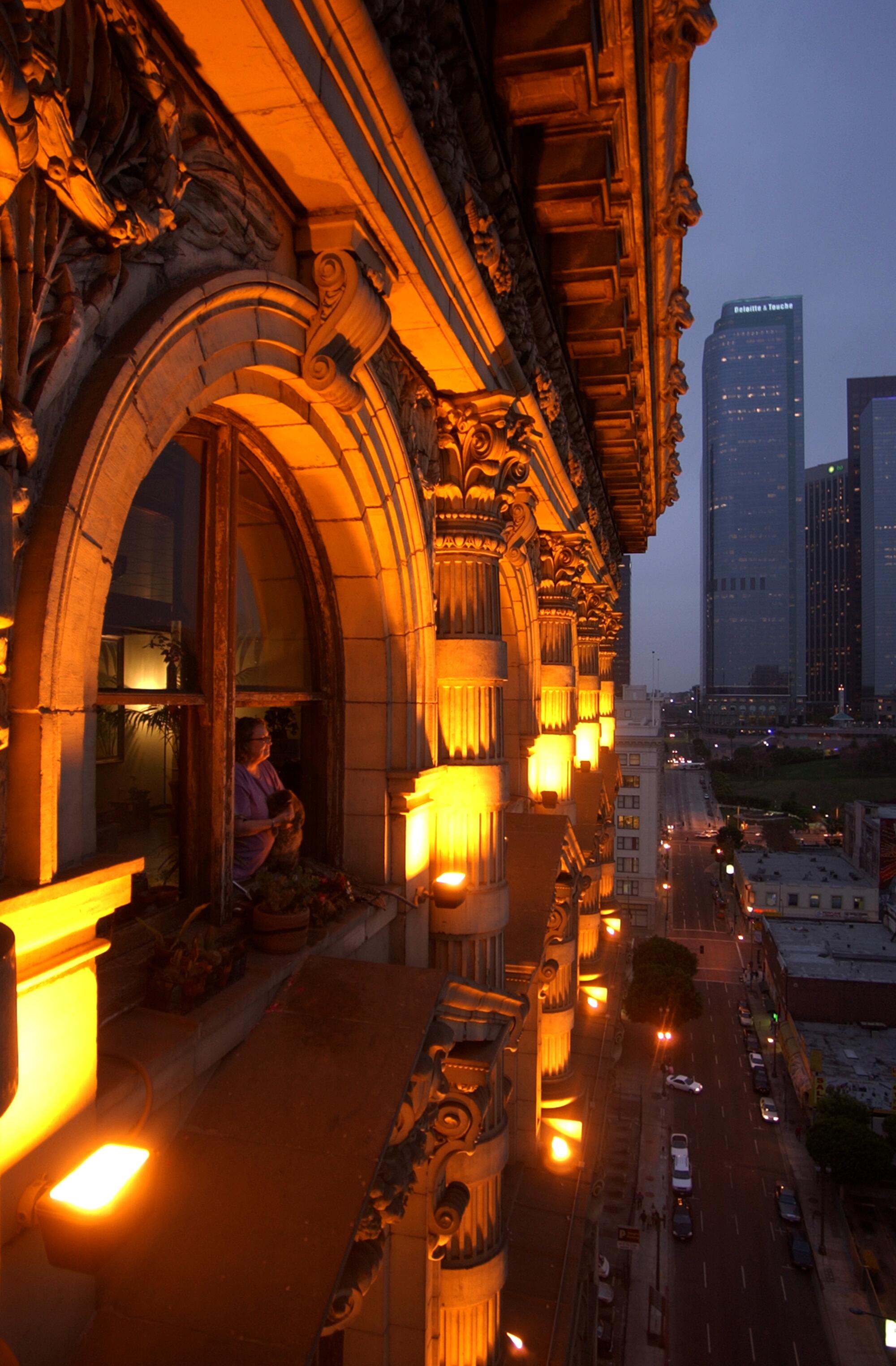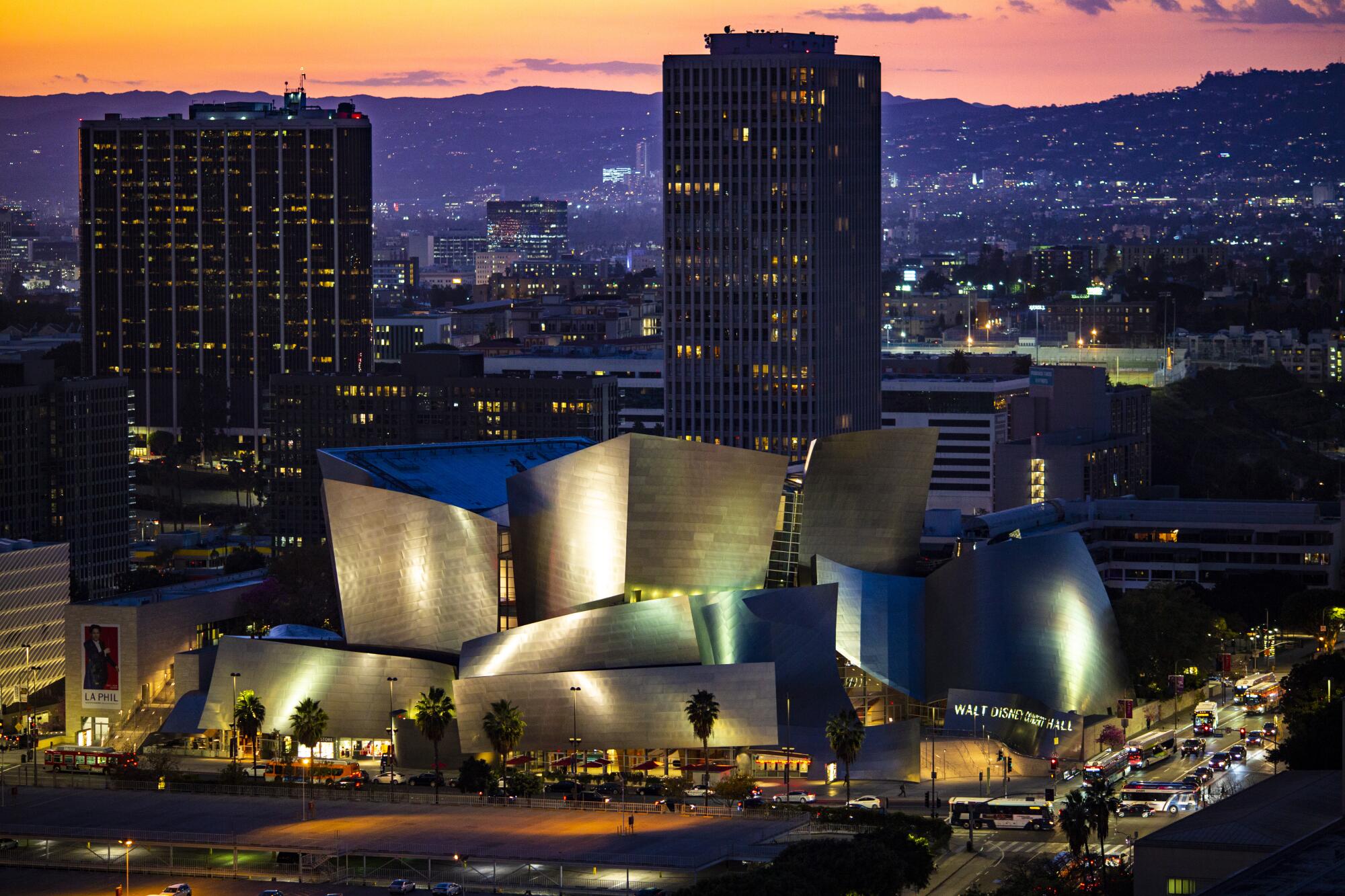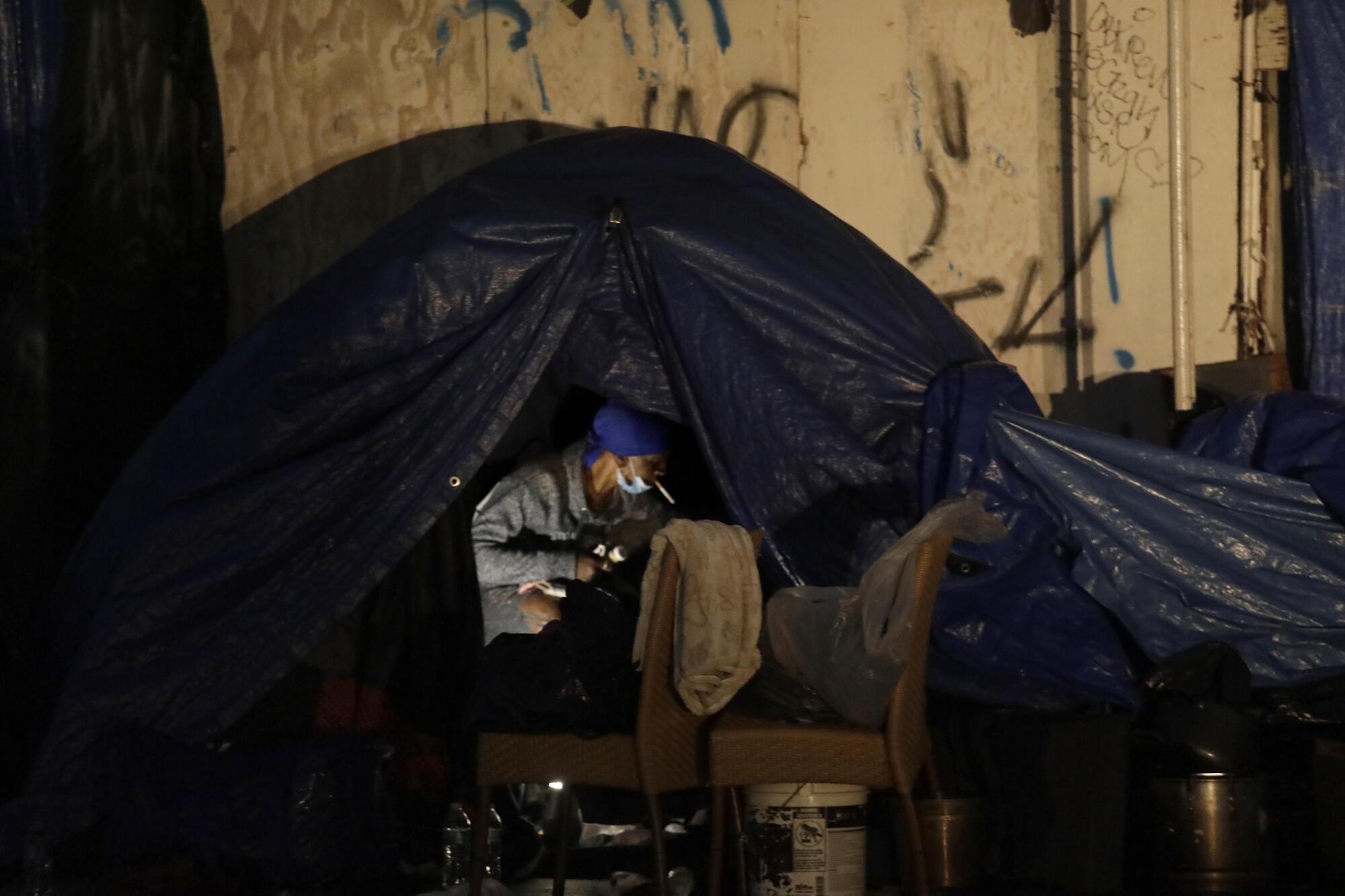
- Share via
One never knows what one might encounter in downtown Los Angeles.
“I’m going to cut your head off,” threatened a man with a tangled beard and untied boots who swept past one day in a sudden gust. I walked on, turning back, watching him cross into the shadow of the Bradbury Building, his big coat blowing like a tattered flag.
But then came a moment of unexpected tenderness.
“I want to sing for you,” said a woman as I headed toward her on the sidewalk.
I held out a dollar in hopes of hurrying along.
“I want to earn it,” she said.
She sang “Amazing Grace” in ripped clothes, her voice a hymn in the traffic. People rolled down windows and listened at the stoplight. No one wanted this rare thing abloom in the dusk to end.
“Now, give me $5,” she said, laughing and holding out her hand to my applause.

When I moved downtown near Pershing Square a decade ago, there were fewer high rises, less gleam. I had just returned from living for years in Rome, Berlin and Cairo as a foreign correspondent and wanted a city that felt at once international and at home, a place of endless languages and an unfinished skyline.
Urban Outfitters had opened in the old Rialto Theatre, but Apple was years away from moving into the Tower Theatre on Broadway. Grand Central Market, once known for cheap produce and tacos, had started the gentrification that would bring in Eggslut, gourmet nut-butter sandwiches and oysters on the half shell. It was a time of ragged splendor. Rents were beginning to edge up, and one could run into a voice actor or a trust-fund baby in cafes. Most people walked their own dogs.

But new buildings quickly rose, and others were rehabbed for lofts and apartments. Sidewalks grew more crowded, and the fluid line between hipsters, tech workers, financiers, drug users and homeless people turned into a strange pageant running east and west of Spring Street.
Shopping carts rattled amid Escalades and Ferraris. A mural of an Indigenous child gazed over Pershing Square. One was struck by the possibility of what a downtown could become against the burden of what it was. I wanted to see how it would all turn out, this map of contradiction where poverty, mental illness and addiction seethed below rooftops of pools, palms and fire pits. Compassion collided daily with the hard eye of survival.
New people arrived, and some of those already here were exposed in troubling ways. The young and well-to-do stepped around slumped bodies while flocking to Whole Foods and ordering boxes of macarons from Bottega Louie. The meth dealer next door to me was hauled away when police showed up with long guns and a battering ram. My former district Councilman José Huizar, who once spoke to residents of my building about a downtown renaissance, pleaded guilty in January to extorting at least $1.5 million in real estate bribes.
Life downtown is navigating the dystopian and the make-believe, the frivolous and the consequential. A vast array of people can be glimpsed when turning a corner or stepping into a back street. A dazed woman in a blanket wandering toward the light of the Metro. Young men driving loud and wild beneath the stars. Drunken lovers kissing outside Perch. A few weeks ago, Joaquin Phoenix, who was filming “Joker 2” just beyond my window, ran through traffic, a painted villain on slippery streets beneath battered marquees.
“The alley behind the Orpheum and the Arts District have this grit and layer to them you can’t re-create,” Caleb Duffy, a film location manager, once told me. “I would have loved to have seen downtown in the 1930s and ’40s. Those theaters alive and open. And the light reflecting off the new buildings going up is amazing. It’s all purposeful. They thought of that. L.A. is pliable. You can turn it into other places.”

It certainly feels like another place when you walk up the stairs alongside Angels Flight to Bunker Hill.
Nature conspires with architecture and the best of the human spirit: Disney Hall, the Broad and the Museum of Contemporary Art rise against the San Gabriels. The visage of Gustavo Dudamel looks over Grand Avenue, and the sounds of oboes, pianos and cellos drift from the Colburn School. A bit farther on, Lincoln Jones and his dancers at the American Contemporary Ballet rehearse in a studio of big windows 28 floors above the city. They move like fireflies against glass.
“It’s still a little crazy down here. We get people with mental problems and on drugs. It’s slowly starting to clean up.”
— Richard Powell, who works at the Last Bookstore
It is different up on the hill. Less disconcerting; the lines, clean. The Victorian houses are long gone, and ghosts — like novelist John Fante, who last century called Los Angeles “you sad flower in the sand, you pretty town” — are occasionally mentioned on walking tours. One thinks of impermanence and renewal. Skateboarders skim and clatter; a woman in a sequined dress, hair piled high, poses for a photographer. Older Asian Americans take afternoon strolls in loops around fountains, stopping to sit and talk near lemon trees and beehives in California Plaza.
Back down the hill — beneath a billboard for a law firm at Fourth and Hill that reads “Stop getting screwed” — are people like Levi and Stephanie. I met them a few years ago when they sailed over the sidewalk, Levi pushing Stephanie in a wheelchair. She was frail and bent and much older. He was twitchy and mercurial. They lived in a small-domed tent that was put up and taken down every day. They were both nomads and addicts; he had gone two years without an arrest warrant and thought maybe he could stay that way.


In the hour or two before nightfall, Levi would park Stephanie in front of the building across the street from mine and assemble the tent. He’d secure the bottom, lay in blankets. He’d return to Stephanie. They’d share a cigarette, watching people pass, keeping an eye out for security guards. The cigarette finished, Levi would lift Stephanie. He’d kneel, ease her into the tent, rub her arms with lotion, tuck her in. He’d go to the curb alone and have another smoke and look at the sky for a few minutes and climb into the tent, pulling the wheelchair in behind him and zipping the flap for the night.
“We need each other,” Levi told me. “She saves me, and I save her.”
Stephanie got sick one day, and Levi took her to Good Samaritan Hospital. He went back a few days later, he said, and was informed that she had died. He lit candle vigils for her on sidewalks. He wandered alone with his tent. Three weeks passed. Stephanie reappeared one morning. She hadn’t died. The hospital had sent her to a nursing home, but she didn’t stay. She wanted to be with Levi. She took a bus. He cried, and they went back to what was. I haven’t seen them in a while.
“It’s still a little crazy down here,” said Richard Powell, who works at the Last Bookstore. “We get people with mental problems and on drugs. It’s slowly starting to clean up. It gets a lot better after 7th Street, with all the new clubs and restaurants. People are moving back. What do you call them, hipsters? All these different people and ethnicities are starting to mesh together. It’s nice.”

Not all of it.
“The homeless guy who lived on the corner died there three weeks ago,” said Powell, his eye over a COVID-19 mask following customers. “He was a panhandler. We called him the ‘dollar man.’ One day he just didn’t wake up.”
I must have passed him, maybe often. Perhaps I gave him a dollar. It is hard to know. Narratives shift and turn, and the faces of anguish and disarray are many. They overpower, then retreat, inseparable from the sirens and the breezes off the coast that cool the twilight. So many voices, spinning in doorways, drifting beneath windows.
My favorite neighbor is a hawk.
He perches on the fire escape of the empty Hotel Clark. He comes often. I watch him from my window. He scans the skyline like a lonely prince. He drops, spreads his wings, takes flight, returns with a pigeon. One day, while he was eating his prey, bloodied feathers spiraled down from the fire escape and floated above tourists walking to the Grand Central Market. They didn’t notice. A few months later, while I was sitting on our rooftop deck, the hawk landed a few feet away, another pigeon in his clutches.
He left a mess and flew away. I thought of the Indigenous child painted over Pershing Square and wondered what it would have been like centuries ago to watch a hawk soar over a land with no buildings, a city not yet realized between desert and ocean. Then to fast-forward to what it is today. A multilingual dream of promise and transgression. The last flame at the edge of the continent. The stuff of movies.
One evening not long ago, the neon sign at the Hotel Clark clicked on. It does that from time to time, casting a pink glow over the street, evoking a sense of 1940s noir in the night. I wonder who turns it on. Perhaps I’ll never know, but that is of no matter. Its infrequency leaves an anticipation of when it might shine again. It is one of the many mysteries that keep me here.
More to Read
Sign up for Essential California
The most important California stories and recommendations in your inbox every morning.
You may occasionally receive promotional content from the Los Angeles Times.













